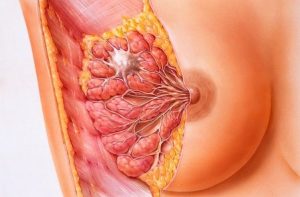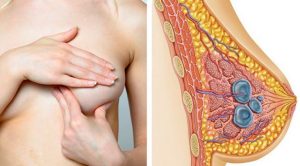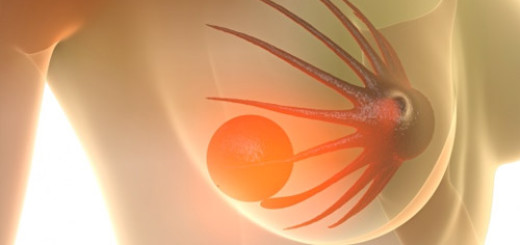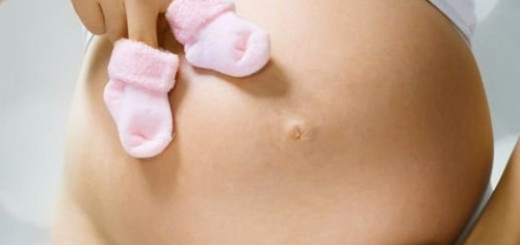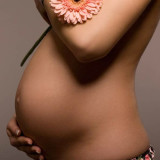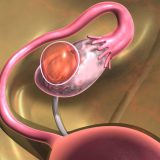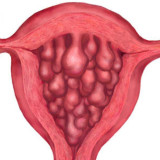If a breast cyst is detected, a woman must be registered with her doctor. This type of disease requires constant monitoring, as well as professional treatment. The breast cyst cannot be cured at home or using folk methods.
What is a breast cyst?
A breast cyst is a cavity whose shell consists of connective tissue. The space inside the cyst is filled with a yellowish or brown liquid. Cystic formation refers to breast dysplasia. However, a cyst is a benign tumor. Most often, a breast cyst is found in women of reproductive age from 18 to 45 years.
In many cases, a breast cyst is considered a manifestation of fibrocystic mastopathy.
Breast Cyst Shape
In the body of a woman, there can be from one to several cysts. Therefore, they are usually divided into two types:
- Single cystic formation – solitary cyst of the mammary gland;
- Multiple cystic formations – polycystic breast
Also, cysts are divided by shape and size:
- Breast cysts of small form – up to 20 mm;
- Large breast cysts – up to 50 mm;
- Giant cysts – more than 50 mm.
Breast cysts can take many forms:
- Fibrous cyst;
- Ductal cyst;
- Fatty cyst;
- Galactocele
What causes a breast cyst?
The main reason for the formation of a cyst in the mammary gland is a violation of the balance of progesterone and estrogen in the body of a woman. Simply put, the patient suffers from hormonal imbalance.
What can provoke the occurrence of cystic formation:
- Genetic factors;
- Neuroendocrine disruptions in the body of a woman;
- A woman over 30 did not have a pregnancy;
- Constant stress;
- Abuse of abortion;
- Hormonal genetic diseases;
- Diabetes;
- Obesity;
- Late and early menopause;
- Premature puberty;
- A woman intentionally does not breast-feed or, on the contrary, abuses breast-feeding a child;
- Incorrect use of birth control pills;
- Trauma to the mammary gland;
- Inflammatory process.
What symptoms do patients with breast cysts have?
A breast cyst that is small does not show for a long time. Due to its size, it does not bring discomfort to a person. At the same time, if the cystic formation reaches a colossal value, then the woman experiences constant unbearable pain.
Most often, patients with a breast cyst complain of chest pain of varying degrees:
- It’s a dull pain;
- Nagging pain;
- jerking pain;
- Bursting pain.
In addition to pain, women experience constant itching and burning in the area of the mammary gland.
Another sign of the existence of a cystic mass is palpation of a round sensitive mass in the mammary gland. A benign tumor is well palpated and has a soft consistency. The large size of the cyst exposes the woman’s breast to severe deformation: sharp growth, asymmetric arrangement of the nipples, etc.
Diagnosis of the disease
To diagnose breast cysts, the doctor conducts a differential diagnosis with fibroadenoma or breast cancer.
The method of palpation in this case is not so effective, therefore, mammography and ultrasound of the mammary gland are used to make a diagnosis.
For breast cancer, not only a cystic formation is characteristic, but also an increase in the axillary lymph node, a change in the color of the skin of the breast and nipples.
What else is included in the methods for diagnosing cysts:
- Ultrasound of the mammary glands. Thanks to this method, the doctor can distinguish between fibroadenoma or cancer from an ordinary breast cyst. He can also find out the structural features of the inner walls of the cystic formation;
- Mammography is an examination of the mammary gland using x-rays in two projections. Thanks to this type of diagnosis, the doctor can draw conclusions about the size, shape and number of cysts;
- Pneumocystography – this study helps to obtain information about the condition of the internal walls of the breast cyst;
- Aspiration of cyst contents with further histological examination.
How is a breast cyst treated?
In the event that the breast cyst has a size less than 20 mm and does not have a tendency to sharp growth, the doctor prescribes monitoring of the cystic formation. For constant monitoring, you need to visit a mammologist and do a mammogram at least once a year.
With a sharp increase in the cyst or a change in the composition of the fluid inside the capsules, surgery is prescribed. The operation is performed using the method of puncture and emptying of the cyst. Sclerotics, such as alcohol, are introduced into an empty capsule. Thanks to this method, the walls of the capsule stick together, not allowing the cystic fluid to constantly accumulate. A small scar appears at the site of cystic formation.
Also, the doctor may prescribe the removal of part of the breast tissue for several reasons:
- If there are several cysts in the mammary gland and they are all multi-chamber;
- If a woman has a history of breast cancer;
- If the cyst is atypical (precancer).
After the operation, the patient should be in a hospital at rest for 1-2 weeks.
